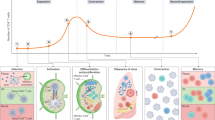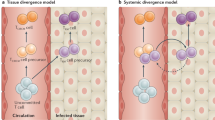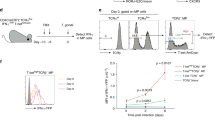Abstract
Naive T lymphocytes travel to T-cell areas of secondary lymphoid organs in search of antigen presented by dendritic cells1,2. Once activated, they proliferate vigorously, generating effector cells that can migrate to B-cell areas or to inflamed tissues3,4,5,6. A fraction of primed T lymphocytes persists as circulating memory cells that can confer protection and give, upon secondary challenge, a qualitatively different and quantitatively enhanced response7,8,9. The nature of the cells that mediate the different facets of immunological memory remains unresolved. Here we show that expression of CCR7, a chemokine receptor that controls homing to secondary lymphoid organs, divides human memory T cells into two functionally distinct subsets. CCR7- memory cells express receptors for migration to inflamed tissues and display immediate effector function. In contrast, CCR7+ memory cells express lymph-node homing receptors and lack immediate effector function, but efficiently stimulate dendritic cells and differentiate into CCR7- effector cells upon secondary stimulation. The CCR7+ and CCR7- T cells, which we have named central memory (TCM) and effector memory (TEM), differentiate in a step-wise fashion from naive T cells, persist for years after immunization and allow a division of labour in the memory response.
This is a preview of subscription content, access via your institution
Access options
Subscribe to this journal
Receive 51 print issues and online access
We are sorry, but there is no personal subscription option available for your country.
Buy this article
- Purchase on SpringerLink
- Instant access to full article PDF
Prices may be subject to local taxes which are calculated during checkout






Similar content being viewed by others
References
Butcher,E. C. & Picker,L. J. Lymphocyte homing and homeostasis. Science 272, 60–66 (1996).
Banchereau,J. & Steinman,R. M. Dendritic cells and the control of immunity. Nature 392, 245–252 (1998).
MacLennan,I. C. et al. The changing preference of T and B cells for partners as T-dependent antibody responses develop. Immunol. Rev. 156, 53–66 (1997).
Garside,P. et al. Visualization of specific B and T lymphocyte interactions in the lymph node. Science 281, 96–99 (1998).
Mackay,C. R. Homing of naive, memory and effector lymphocytes. Curr. Opin. Immunol. 5, 423–427 (1993).
Austrup,F. et al. P- and E-selectin mediate recruitment of T-helper-1 but not T-helper-2 cells into inflamed tissues. Nature 385, 81–83 (1997).
Ahmed,R. & Gray,D. Immunological memory and protective immunity: understanding their relation. Science 272, 54–60 (1996).
Zinkernagel,R. M. et al. On immunological memory. Annu. Rev. Immunol. 14, 333–367 (1996).
Dutton,R. W., Bradley,L. M. & Swain,S. L. T cell memory. Annu. Rev. Immunol. 16, 201–223 (1998).
Gunn,M. D. et al. A chemokine expressed in lymphoid high endothelial venules promotes the adhesion and chemotaxis of naive T lymphocytes. Proc. Natl Acad. Sci USA 95, 258–263 (1998).
Campbell,J. J. et al. Chemokines and the arrest of lymphocytes rolling under flow conditions. Science 279, 381–384 (1998).
Campbell,J. J. et al. 6-C-kine (SLC), a lymphocyte adhesion-triggering chemokine expressed by high endothelium, is an agonist for the MIP-3β receptor CCR7. J. Cell Biol. 141, 1053–1059 (1998).
Mackay,C. R., Marston,W. L. & Dudler,L. Naive and memory T cells show distinct pathways of lymphocyte recirculation. J. Exp. Med. 171, 801–817 (1990).
Baggiolini,M. Chemokines and leukocyte traffic. Nature 392, 565–568 (1998).
Gunn,M. D. et al. Mice lacing expression of secondary lymphoid organ chemokine have defects in lymphocyte homing and dendritic cell localization. J. Exp. Med. 189, 451–460 (1999).
Michie,C. A., McLean,A., Alcock,C. & Beverley,P. C. Lifespan of human lymphocyte subsets defined by CD45 isoforms. Nature 360, 264–265 (1992).
Baron,J. L., Madri,J. A., Ruddle,N. H., Hashim,G. & Janeway, C. A. Jr Surface expression of alpha 4 integrin by CD4 T cells is required for their entry into brain parenchyma. J. Exp. Med. 177, 57–68 (1993).
Wu,L. et al. CCR5 levels and expression pattern correlate with infectability by macrophage-tropic HIV-1, in vitro. J. Exp. Med. 185, 1681–1691 (1997).
Sallusto,F., Mackay,C. R. & Lanzavecchia,A. Selective expression of the eotaxin receptor CCR3 by human T helper 2 cells. Science 277, 2005–2007 (1997).
Tang,H. L. & Cyster,J. G. Chemokine up-regulation and activated T cell attraction by maturing dendritic cells. Science 284, 819–822 (1999).
Sallusto,F., Lenig,D., Mackay,C. R. & Lanzavecchia,A. Flexible programs of chemokine receptor expression on human polarized T helper 1 and 2 lymphocytes. J. Exp. Med. 187, 875–883 (1998).
Grewal,I. S. & Flavell,R. A. CD40 and CD154 in cell-mediated immunity. Annu. Rev. Immunol. 16, 111–135 (1998).
Abbas,A. K., Murphy,K. M. & Sher,A. Functional diversity of helper T lymphocytes. Nature 383, 787–793 (1996).
Kagi,D., Ledermann,B., Burki,K., Zinkernagel,R. M. & Hengartner,H. Molecular mechanisms of lymphocyte-mediated cytotoxicity and their role in immunological protection and pathogenesis in vivo. Annu. Rev. Immunol. 14, 207–232 (1996).
Casamayor-Palleja,M., Khan,M. & MacLennan,I. C. A subset of CD4+ memory T cells contains preformed CD40 ligand that is rapidly but transiently expressed on their surface after activation through the T cell receptor complex. J. Exp. Med. 181, 1293–1301 (1995).
Hamann,D. et al. Phenotypic and functional separation of memory and effector human CD8+ T cells. J. Exp. Med. 186, 1407–1418 (1997).
Sprent,J., Tough,D. F. & Sun,S. Factors controlling the turnover of T memory cells. Immunol. Rev. 156, 79–85 (1997).
Tanchot,C. & Rocha,B. The organization of mature T-cell pools. Immunol. Today 19, 575–579 (1998).
Weng,N. P., Hathcock,K. S. & Hodes,R. J. Regulation of telomere length and telomerase in T and B cells: a mechanism for maintaining replicative potential. Immunity 9, 151–157 (1998).
Acknowledgements
We thank K. Hannestad and K. Karjalainen for critical reading; J. C. Howard for his help as ‘wordsmith’; M. Dessing and A. Pickert for cell sorting; A. Hoy for help in the initial experiments; LeukoSite Inc., Cambridge, Massachusetts for providing antibodies to chemokine receptors; and L. Wu for providing the CCR7 and CCR4 antibodies before publication. The Basel Institute for Immunology was founded and is supported by F. Hoffmann-La Roche Ltd, Basel, Switzerland.
Author information
Authors and Affiliations
Corresponding author
Rights and permissions
About this article
Cite this article
Sallusto, F., Lenig, D., Förster, R. et al. Two subsets of memory T lymphocytes with distinct homing potentials and effector functions. Nature 401, 708–712 (1999). https://doi.org/10.1038/44385
Received:
Accepted:
Issue Date:
DOI: https://doi.org/10.1038/44385



